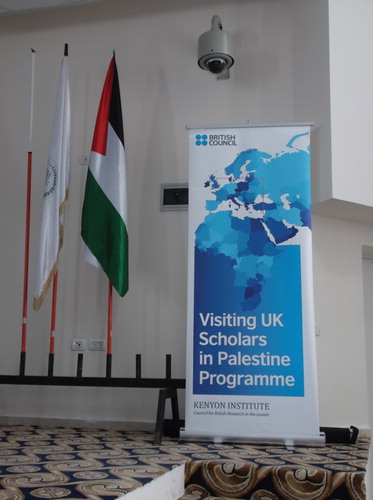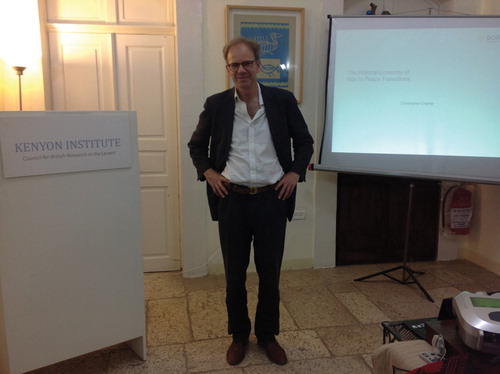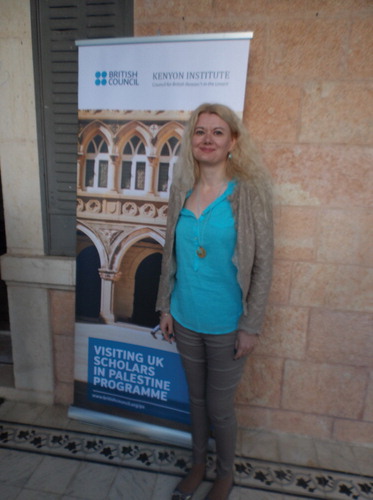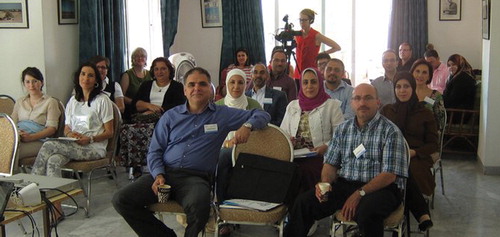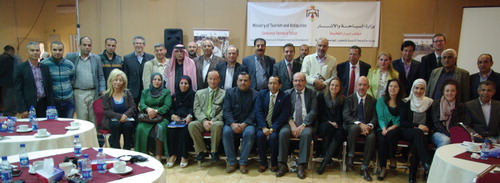From the Chair
I succeeded Henry Hogger as Chair of the CBRL in December 2013 but I was also his predecessor (2004–2008) and I was Chair of the British Institute at Amman for Archaeology and History (BIAAH) from 1993 to 1999 when it merged with the British School of Archaeology in Jerusalem (BSAJ) to form the CBRL. So, I have seen the quite extraordinary changes that have taken place over the last 21 years: the merger; the extension of the CBRL’s role to support research across the whole of the humanities; and the quite dramatic increase in the level of activities even in the last five years. It is astonishing what has been done and a great tribute to the people working for the CBRL and those collaborating with us. None of this could have happened without the support of the British Academy, but it is the extent and quality of the CBRL performance that has persuaded the Academy to provide us with resources.
Despite this we will have to demonstrate that we can do even more to maintain our level of support. There will be a new multi-year spending review in 2015 and the expectation is that—whatever party wins the elections—there will be continued pressure to reduce spending. At best, we can hope to maintain the present level of funding, but we also need to do much more to raise money from other sources. We are drawing up a fundraising strategy and looking at how we can collaborate more with others both in conducting research and providing services such as our co-operation with the Institut français du Proche-Orient (IFPO) in Beirut and Jerusalem.
We would also like to refurbish the Kenyon Institute which has long been in need of an injection of substantial funds. We are trying to break down the requirement into a number of smaller packages for which we can seek money. The Kenyon has been transformed over recent years thanks to the imaginative improvements made by Mandy Turner and her staff and the support we have had from the British Consulate, the Altajir Trust, the Barakat Trust and others. I am conscious of how much more could be achieve if we could enhance the premises which help bring Palestinian and Israeli scholars together.
The British Institute in Amman goes from strength to strength and I am looking forward to visiting it in September to meet those working there and attend the workshop on the Arab Spring organized by CBRL London and the Institute, and supported by the MBI Al Jaber Foundation. We would like to develop the facilities there when the funds and opportunity arises. The Institute has a fine reputation in Jordan and all on the Council want to acknowledge what Carol Palmer and her colleagues have managed to achieve. We are particularly grateful for the encouragement we receive from HRH Prince El Hassan and Princess Sumaya, as well as Peter Millet, the British Ambassador.
We are determined to do what we can to maintain research on Syria and position the CBRL for the day (which regrettably seems distant) when we actively engage in research on the ground. At the same time, we are supporting more on the wider Middle East region as and when resources allow. It is now clear that the events of 2011 were the start of profound changes in the region that will face us with major challenges over the next few years, possibly a lot longer. Though we can help policy makers and others understand what is happening there is little we can do to influence it and will have to learn how best to adapt to the changes.
Lord Stern, President of the British Academy, recently visited Amman and was struck by the contribution that our work on early prehistory can contribute to understating climate change and other phenomena. The Academy is now considering organizing an event in 2015 that will highlight the relevance of much of our research into the past in understating problems of the present and future. His visit showed us that we also need to do more in the UK to highlight the contribution that we make to research and scholarship in all the fields we cover. As a step towards this, we are considering organizing a one- or two-day conference in London to bring this to the attention of policy makers and those that can influence the level of resources receive.
I would like to pay tribute to the work of all our staff, particularly to Bill Finlayson, the chief executive, for his calm approach, immense knowledge of how the CBRL works and the quality of his scholarship, which does much to add to the CBRL’s reputation. We have fine directors in Mandy and Carol, whilst Penny McParlin ensures that the CBRL functions smoothly—ably supported by our local staff in Amman and Jerusalem. Paddy Altern, the Honorary Treasure, stands down this year. I want to thank him on behalf of all the trustees for managing our finances and advising us on the best ways of spending and saving money. Thank you on behalf of all to them and the other honorary officers, staff and trustees.
Lord Nick Stern, President of the British Academy, visiting the CBRL British Institute in Amman, 9 June 2014. Front row, from left: Farhanah Mamoojee (CBRL Intern), Vanessa Iaria (CBRL Visiting Research Fellow), Nick Stern (President of the British Academy), Lindsay Holman (PhD candidate at Chapel Hill, USA). Back row, from left: Nadja Qaisi (British Institute Amman Finance Administrator), Rudaina Momani (British Institute Amman Librarian), Andrea Zerbini (CBRL Visiting Research Fellow), Firas Bqa’in (British Institute Amman Events Administrator), Carol Palmer (British Institute Amman Director), Francesca Burke (CBRL Research Fellow), Emily Poore (MA student, University College London), Russell Adams (University of Waterloo, Canada), Zoe-Louise Robinson (CBRL Visiting Research Scholar)
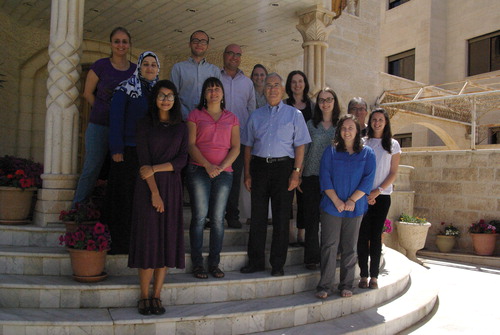
From the Director
Any introduction to our Bulletin has to comment on the current context of our work, but at present any such comments seem inadequate. In the last few weeks before writing this, the region has gone from being depressingly much the same as last year, to a rapid escalation of conflict and human tragedy, from the kidnapping and murder of teenagers in the occupied Palestinian territories and Jerusalem, the sudden advance of ISIS and the declaration of a new caliphate, rocket fire by Hamas, a massive response by Israel against Gaza, shooting and fighting in the usually calm streets around the Kenyon Institute, to signs that Lebanon is being drawn more and more into the Syrian conflict. Jordan appears relatively calm, but you can’t help but feel this is at least in part because everyone is keeping their heads down as the neighborhood goes up in smoke. Cultural heritage becomes another casualty, from damage inflicted simply because there is fighting, to damage produced by looting conducted to raise funds for more conflict, and ultimately to deliberate destruction created out of religious intolerance.
Channel 4’s Paul Mason recently provided a short history lesson in his blog (blogs.channel4.com/paul-mason-blog/brit-gaza-fault-line-heard-lot/2094), reminding everyone in the UK that many Palestinians over 50 blame their current situation on the Balfour Declaration. I’ve had Israelis explain to me that their use of collective punishment, or of demolishing houses, is simply following British methods from the Mandate. The declaration of a new caliphate has the media reminding us all that the boundaries within the modern Middle East are the product of the western powers’ post-war settlement. The basic message is the same; it is all our fault. The ceremonies commemorating the start of the First World War that are taking place at the same time seem almost to reinforce this message. But Paul Mason’s lesson does not end with Balfour, nor does he accept the triumphalist message that seems to lurk behind some of the commemoration—he reminds us that British popular memory of the war was dominated by the idea that war is hell, and that the only good that could come of it would be if it ended wars. The situation today is not the product of Balfour, but of 100 years of subsequent history, of ‘war, betrayal, genocide, and the failure of secular ideologies’. Balfour’s declaration was a product of its time, given substance to help generate sympathy in America, perhaps to persuade revolutionary Russia to stay in the war. History does not have a starting point, and we would be as well trying to look for the causes of Balfour in the causes of the First World War, or Russian pogroms. That the safeguards for the Palestinian population that were built into the 1917 declaration were ignored in the 1940s was a product of the Second World War. And the conflicts happening now, they are today’s conflicts and their solution can only be in the present. Context is important, and one of our contributions can be to help understand it and to make sure people do not create simplistic narratives to excuse their actions or to deny agency in the modern world.
There remain moments of optimism. I was particularly struck by the resilience of Syrian refugees in the south of Jordan this spring. Refugees who had come and set up shop seemed to be leading an urban renaissance in small towns—and remained hospitable and generous. Despite farewell cries of ‘see you in Damascus’ it is hard to see many of these people ever going back to Syria, and you feel that whatever battles are taking place, or declarations of new frontiers, we are seeing a new and irreversible process happening through the everyday actions of ordinary people.
We finally managed to go ahead with our advanced Arabic course in Beirut, postponed last year due to FCO advice not to travel issued the day before course started—a consequence of fears that the US would begin air bombing in Syria in September 2013. I visited the course, and in the slightly dream-like state induced by some terrible bowel plague received in Jordan, was delighted by Beiruti taxi drivers who went out of their way to look after me. Despite (or perhaps because of) not being quite on the right planet, I couldn’t help but enjoy the story of one of our course participants. He had cheerfully greeted security at Beirut airport in Arabic. Given the airport’s location, security is run by Hezbollah who, of course, feared he might be some western Jihadi on his way to join some group in Syria. While I sympathize with him for spending a night at the airport while this was sorted out, I do take some considerable pleasure knowing that British intelligence concerns about British Jihadis are being looked after by Hezbollah.
We’ve had our own sad moments within CBRL this year too. We were shocked by the completely unexpected death of Ghazwa Malhas, our librarian in Amman. She had made a huge difference to the library and had become a good friend to many of the CBRL community. She will be sorely missed. Her assistant, Rudaina Momani, is now running the library by herself. We were equally upset by the death of Abu Fawaz, our longstanding guard in Wadi Faynan, well known to all the teams who have worked there over the years. Abu Fawaz to many people was Wadi Faynan, and the place will not be the same without him.
Despite everything, the work of the CBRL goes on. The pages of this Bulletin illustrate just how diverse the work is, from Claire Rambeau’s work on the environment of southern Jordan 40,000 years ago to Caitlin Robinson’s research on cosmetic surgery in Beirut. One of the challenges for CBRL is to ensure that this diverse academic community can rise above the specific and be seen to be playing a part in our overarching research themes. In this regard Paul Burtenshaw and Carol Palmer’s feature article provides something of an introduction to a new British Academy Strategic Development Programme project we will be starting soon, looking at the Deep Past as a Social Asset in the Levant. In addition to its primary research objective, this project is also intended to help bring together a broad spread of disciplines in an inter-disciplinary study, connecting archaeology, anthropology, rural economics, and tourism. This project has grown organically out of longstanding interests and the way the CBRL has engaged with local communities over time. It will provide a very clear illustration of why such an on the ground long-term presence is an essential part of how to make research have a real impact. Paul and Carol (assisted by Firas Bqa’in) were also integral parts of a Ministry of Tourism conference in Tafileh, also intended to help develop a greater spread of tourism in the country.
Cherine Hussein finally made it to the Kenyon Institute, visa in passport, to join Mandy Turner and the team, now including Mansour Nasasra, our postdoctoral researcher working on another British Academy Strategic Development project, Twenty years of the ‘Oslo peace paradigm’: an assessment of its achievements and limitations. Francesca Burke, our postdoctoral researcher on the third of these Strategic Development projects, Higher Education and Political Change in the Arab World: What Role for the Social Sciences?, has continued to be based at the British Institute in Amman. The latest good news is that she now has a job to go to at Brighton University once her fellowship at CBRL is complete. She has already promised that she will continue to be engaged with the follow up plans we have for this project.
We have always had strong programmes of conferences, lectures and seminars at or centres in the Levant, and relatively few events in the UK. We are in the process of changing that, to give greater visibility to our work within the UK. In addition to our lectures, this year (2014) on the 6th of December in partnership with the UCL Petrie Museum and ASTENE (The Association for the Study of Travel in Egypt and the Near East), we will hold an event exploring the archaeology of Lawrence of Arabia as a commemoration of the start of the First World War. The event will include Dr Neil Faulkner of the CBRL-affiliated Great Arab Revolt project talking about the archaeology of Lawrence’s guerilla warfare. Next year, on the 29th and 30th of June 2015, we will be holding a conference Digging up Jericho: Past, Present and Future with the Institute of Archaeology at UCL (where the meeting will take place) and the University of Applied Sciences at Utrecht. In addition to discussion of archaeological research, the meeting will include a consideration of cultural heritage management, connecting it with our Deep Past project. Keep a watch on our website for details of these and other meetings.
Altogether now! A rare photo of CBRL staff from our offices in London, Jerusalem and Amman all in one place while attending a finance training course in Amman. From left to right: Carol Palmer (British Institute in Amman Director), Penny McParlin (CBRL London Administrator), Francesca Burke (BI Amman Research Fellow), Mandy Turner (Kenyon Institute Director), Bill Finlayson (CBRL Regional Director), Micaela Sinibaldi (valued friend of the CBRL) and Firas Bqa’in (BI Amman Events Administrator). Maida Smeir (KI Administrator) and Nadja Qaisi (BIA Finance Administrator) excused themselves to do a little shopping instead of attending the dinner pictured. Taken in Amman, October 2013
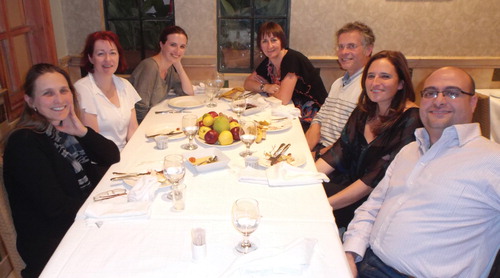
Implementation of our new financial system provided a rare opportunity for all of our administrators, Penny McParlin, Nadja Qaisi, and Maida Smeir, to get together for training in Amman. The practical implementation of this has been proceeding well, and our hope that it would free up some of Penny’s time is beginning to bear fruit. Fundraising plans are starting to move forward, we have now received a technical report on the Kenyon Institute property (very kindly funded by Menas Associates) and we will be moving forward soon with developing detailed plans and cost estimates for the works. We are deeply grateful to the MBI Al Jaber Foundation, who have funded bursaries for five students to come out to Amman to attend our The Arab Uprising: Researching the Revolutions conference to be held in September this year, and to Menas Associates who have provided additional support.
As ever, we are grateful for the support of the British diplomatic missions to the region. Cooperation with the British Council has continued to develop, both in Jerusalem and the oPt where the Visiting Scholars in Palestine programme continued as a very successful activity, and in Amman where the British Council joined in with our British Academy MENA panel sponsored Translation Studies Workshop programme. We continue to be extremely grateful for the support offered by our patron, Prince Hassan bin Talal, and by Princess Sumaya bint El Hassan, and to the collaboration with the Royal Scientific Society.
From the Editor
This issue marks the 11th year that I have served as Editor of the CBRL Bulletin and its predecessor, the CBRL Newsletter. In 2015, I will be stepping down from the role, and the Bulletin will be managed by the CBRL’s London Office and merged with the CBRL’s Annual Report. As a consequence, it is likely to take a slightly different form. At such a time, as well as in light of the critical events that are going on in the region, it seems appropriate to review the development of the Bulletin—CBRL’s annual document of record—to this point and its contents. There is much to tell, both in terms of the development of CBRL and events in the Levant and Middle East more broadly.
The CBRL Newsletter began in 2001 and the first editor was Dr Michael Given, who served as Editor for the first three editions before moving to serve as CBRL Monographs Editor, a post he fulfilled until 2006/7. Last year, 2013, marked the final publication of the two volumes on the archaeological survey in the Troodos Mountain range of central Cyprus that Michael directed (see the monographs section at the end of this Bulletin), and which featured in newsletter reports between 2001 and 2004. The publication of these volumes indicates that Michael and his team have certainly been very busy since he stepped down from his leading roles in CBRL. Returning to the first issue of the CBRL Newsletter 2001, as then CBRL Post-doctoral Fellow at the University of Leicester, I contributed a feature article documenting and reflecting upon a long trek in southern Jordan up the Rift Valley mountain range from the bottom of the Wadi Araba to the area of Shawbak at the top, and back down again. I made that journey with Alison McQuitty, former CBRL Director, and Isabelle Ruben, long-time CBRL member and friend of CBRL, with CBRL’s Wadi Faynan guards, Abu Fawaz from the Rashaydah and Jouma ‘Ali Zanoon from the ‘Azazme as guides—not to leave out the Pasha’s daughter, Buthayna Rashaydah, who also accompanied us. Sadly, Abu Fawaz passed away in December 2013, and is fondly remembered in this issue of the Bulletin. His passing has the sense of the end of an era for CBRL Amman.
The article on our journey up the Rift Valley was one of the first to be published in the CBRL Newsletter / Bulletin with a more ‘contemporary’ rather than archaeological or historical focus, quaintly titled ‘Travels of an Anthropologist in Southern Jordan’—a title which the then Editor suggested. My own expertise and education, in fact, sit somewhere between archaeology and anthropology as I have travelled my own journey between environmental archaeology—first specializing as an archaeobotanist—then moving on to ethnobotany and ethnoarchaeology, and from there into ethnography and anthropology more broadly, but always with a strong interest in the history of the Levant. In reviewing the shifts in CBRL, it is hard not to feel that my personal progression reflects a transition in CBRL also, but that recent events have played an even stronger role.
Reports published in the Newsletter and Bulletin do not necessarily represent all projects supported (either directly through financial support or through affiliation) by CBRL in any one year. Furthermore, a report may represent the results of an archaeological field season encompassing many people or that of a single individual awarded a Pilot Project Award, Fellowship or a Travel Grant, which in themselves represent very different levels and scales of project in terms of the status of the writer, the level of funds awarded and the length of the award. Nevertheless, the results are very much reflective of the organization’s changing activities. Since 2001, the number of feature articles and research reports published has ranged from 18 in 2001 to 36 in 2009, with an average of 28 reports per year, as in this edition. Since 2005, the number of reports has been nearer 30 and above, but with a notable dip in 2011, which coincides with the upheavals caused by the onset of the ‘Arab Spring’.
CBRL was founded in 1998 and combines both the British School of Archaeology at Jerusalem (BSAJ), since 2001 the Kenyon Institute, and the British Institute at Amman for Archaeology and History (BIAAH), now simply referred to as the British Institute in Amman. The implications of the then new organization’s broader remit to cover the full range of humanities and social sciences supported by the British Academy, CBRL’s main sponsor, are fully evident in the contents of the Bulletin and its predecessor, the Newsletter. The first chart shown here () summarizes the distribution of reports since 2001, with their subject matter categorized by the broad chronological classifications of ‘Archaeology’, ‘History’ and ‘Contemporary’, the last being a term used as a short-hand for subjects like anthropology (a field, like history, that has always been supported by CBRL and its predecessors), as well as newer areas such as international relations, political science and sociology, among others.
Chart 1:. Published reports (feature articles and research reports) in the CBRL Bulletin categorized by archaeological, contemporary studies or historical subjects, 2001–2014. Data compiled by Carol Palmer and Firas Bqa’in
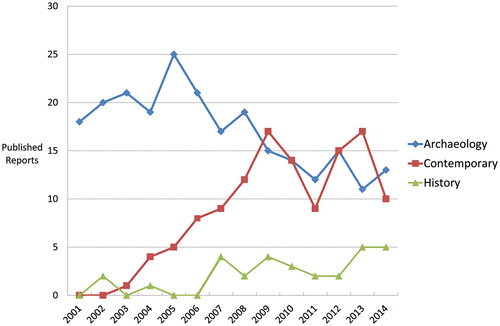
In 2001, if my own contribution is excluded, all contributions were reports on archaeological fieldwork and associated studies. The first more purely ‘contemporary’ report was a feature article in 2003 prepared by Sean Ireton on the Samaritan communities of Israel/Palestine. ‘Contemporary’ contributions grew steadily after that point, with a fairly even split between archaeology and contemporary subjects in the Bulletin after 2009. The number of archaeological reports, overall, has generally decreased as the remit of the organization expanded. Increasingly, though, archaeologists are working with local communities in addition to local academics, and so the categories are becoming less distinct, but for the purposes of this analysis such articles are treated as ‘archaeology’. Historical studies have regularly been sponsored and featured in CBRL—albeit it as a minority—but it is interesting to note that history features more strongly in the 2013 and 2014 editions. This perhaps reflects a future trend as researchers look increasingly for the seeds of the current state of the region in the recent past and also, pragmatically, as access to many areas of the region have closed.
The second chart () shows articles published in the Newsletter and Bulletin by country, though excluding reports from the Levant region to keep the chart more readable. Geographically, coverage generally favours the southern Levant, with report coverage between Jordan and Israel/Palestine fairly evenly matched since 2007. This is perhaps to be expected due to the location of CBRL’s two long-standing institutes in the region. Jordan has maintained relatively steady coverage within the pages of the Bulletin, ranging between seven to 12 reports annually. However, between 2001 and 2006, reports on Palestine/Israel were less numerous and represented on par with those from Syria, Lebanon and Cyprus. Since 2007, with the exception of 2011, there have been eight or more, up to a maximum of 12 in 2013 on Israel/Palestine. The lowest number of reports comes from the 2011 ‘dip year’ that coincides with the start of the ‘Arab Spring’.
Chart 2:. Published reports (feature articles and research reports) in the CBRL Bulletin categorized by country of research, 2001–2014. Data compiled by Carol Palmer and Firas Bqa’in
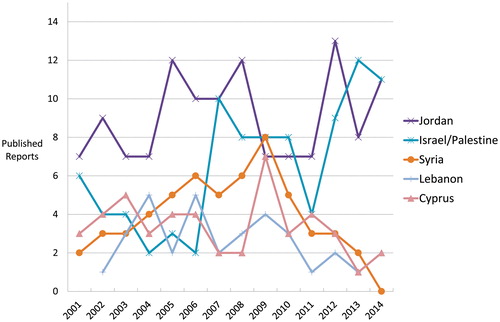
The third chart () shows that, since 2007, the increase in reporting from Palestine/Israel is due to articles investigating the contemporary situation. Articles cover subjects such as peace activism, the construction of the Separation Wall, religious parties in Israeli democracy, visual culture, and analyses of development and neoliberal policies within the occupied Palestinian territories. Articles in this issue link to an increasing recognition of the failure of the Oslo Process (e.g. articles by Cherine Hussein and Mandy Turner). It is intriguing that while CBRL supports studies on the history of Israel/Palestine, and this appears to be increasing in Israel/Palestine, it is a missing element from Jordan, as shown in the fourth chart (), where the coverage is primarily archaeological with some contemporary reporting.
Chart 3:. Published reports (feature articles and research reports) from Israel/Palestine in the CBRL Bulletin categorized by archaeological, contemporary studies or historical subjects, 2005–2014. Data compiled by Carol Palmer and Firas Bqa’in
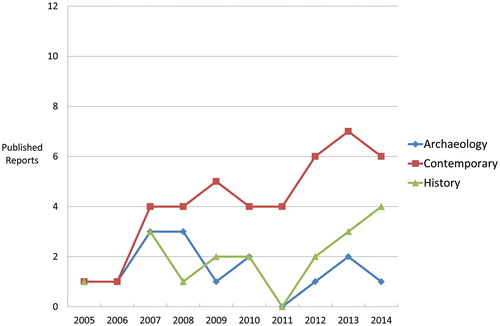
Chart 4:. Published reports (feature articles and research reports) from Jordan in the CBRL Bulletin categorized by archaeological, contemporary studies or historical subjects, 2005–2014. Data compiled by Carol Palmer and Firas Bqa’in
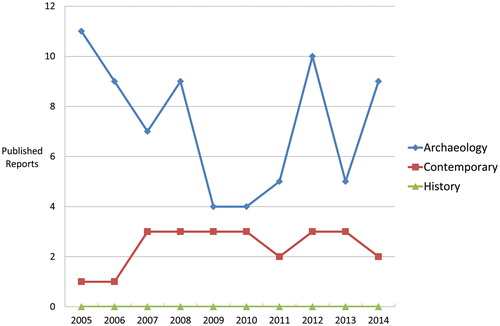
In terms of the northern Levant, reports on activities in Syria peaked in 2009. Since that time, numbers have decreased, with no reports from Syria included in this edition. Given the increasing level of activity earlier and the richness of it, it is not surprising that the CBRL moved to open a British Institute in Damascus there in 2009. It is impossible to travel to Syria due to the security situation at the present time. In Lebanon, the travel situation can also be difficult, with Foreign and Commonwealth Office (FCO) advice advising against travel, most recently in September 2013. In the last two editions of this Bulletin, there have only been one or two reports concentrating on Lebanon, compared with a peak of five in 2004 and again in 2006 when Lebanon was highlighted in the first issue of the CBRL Bulletin. In summary, events in the region have therefore served to concentrate CBRL’s fieldwork research to the southern Levant, in both contemporary and archaeological studies. Finally, for Cyprus, there are usually between three to four reports each year, and for the last two years only two, but with a peak of seven in 2009, the largest issue of the Bulletin to date.
Moving away from country coverage representation, research themes were first introduced as part of CBRL’s research strategy in 2005. In 2008, the Bulletin caught up with this change and shifted from presenting research reports by country to those based on themes. The last chart in this series () is based on data from the CBRL Annual Report and awards made, not reports published in the Bulletin. Affiliated reports are not represented because they had not all yet been awarded at the time of reporting.
Chart 5:. Awards made categorized by CBRL research theme, 2005/6–2014/15. Original data compiled from CBRL Annual Reports. Data compiled by Carol Palmer
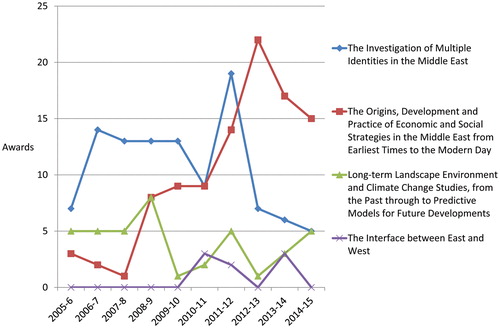
Initially, the ‘Multiple Identities in the Levant’ theme—closely linked with CBRL’s major strategic research initiative ‘Exploring Identities in the Levant’—contained the largest number of reports. Recently, however, this has dramatically tailed off after a peak in 2011/12. Replacing it, ‘The Origins, Development and Practice of Economic and Social Strategies in the Middle East from Earliest Times to the Modern Day’ theme (hereafter, ‘Economic and Social Strategies’) has dramatically expanded, and is currently by far the largest single category. Since 2012/13, ‘Economic and Social Strategies’ has been larger than all the other themes put together by the following ratios: 22:8 (2012/13); 17:12 (2013/14) and 15:10 (2014/5). This appears to be correlated with the events following the ‘Arab Spring’ when research agendas shifted dramatically. Earlier, the ‘Economic and Social Strategies’ theme made its first jump in 2008/9, and it can be reasonably argued that this can be linked with the economic crash of 2008. With large parts of the region currently affected by war and population displacements, the celebration of diversity and richness that the theme ‘Multiple Identities in the Levant’ was arguably conceived to celebrate can feel sadly distant at a time when homes and heritage are plundered and destroyed, land seized, people flee, and all too many die.
To end on a different note, it remains my pleasure to thank this year’s excellent intern, Farhanah Mamoojee (now with the Gingko Library in London), who has ably assisted me in the editing and compiling of this year’s edition, along with CBRL Admin Secretary, Penny McParlin, for her efficiency in administering receipt of reports and following up on copyright issues on behalf of CBRL. I would particularly like to thank the staff at Maney Publishing. They have been a pleasure to work with since 2008 when they assumed responsibility for the production of the CBRL Bulletin as well as of Levant. I thank Nick Hunt who stepped down as Bulletin Production Editor this year, to be replaced by Geetha Nair, Maney Publishing Production Manager, who also previously worked on the Bulletin before her promotion. Liz Colquhoun (formerly Rosindale), in her role as Publishing Manager for the Humanities, has been a wise guiding hand from the beginning. Finally, I would like to thank all the contributors over the years for their energy and insights. As this brief analysis shows, the pages of the Bulletin are a genuine reflection of developments in the region, as well astute individual research analyses in their own right.
Carol Palmer,
CBRL British Institute in Amman Director
CBRL EVENTS AND INITIATIVES
Kenyon Institute Report: the Visiting Scholars in Palestine Programme, 2012–14
Exchanging Knowledge and Ideas
‘The Visiting UK Scholars in Palestine programme was a valuable experience. It allowed me to disseminate my work on peacebuilding, statebuilding, and local ownership, in a context where such issues are very important. I gained feedback from several very engaged and sophisticated audiences, and made some local academic contacts which will be important to my work in future. It also provided me with some useful and balanced insights into the political situation in Israel/ Palestine. It has been of assistance in relation to my own teaching, with students eager to hear about my impressions and experiences. I could not recommend this programme more, and I am very grateful to have been invited to take part.’
Professor Oliver P. Richmond, IR, Peace and Conflict Studies, University of Manchester, VSP Visit 1: 27 February–2 March 2012
In February 2012, the Kenyon Institute (KI) started its partnership with the British Council Palestine (BCP) on the Visiting UK Scholars in Palestine Programme (VSP) which brings leading UK-based scholars to the occupied Palestinian territory (oPt) for a speaking tour of universities and public venues. The idea for the programme was developed by KI Acting Director Omar Shweiki (2010–2011), and British Council Palestine Director Sandra Hamrouni (2009–2012), and it was implemented once I, the new director, took up my post in January 2012 (seconded from Bradford University’s Peace Studies department). The rationale behind the programme was to enable Palestinian students, academics and the public to interact and engage with leading scholars from the UK, to enhance research links between the oPt and the UK, and to expose UK-based scholars to the situation in the oPt. The KI and the BCP thus saw this programme as a two-way learning experience—with the desire to build lasting relationships in the academic sphere between the UK and the oPt. Unfortunately, given the blockade of Gaza and the difficulty of obtaining permission to enter from the Israeli military authorities, it was not possible to take the scholars there—and so the visitors were confined to the West Bank (including East Jerusalem). Plans to do video link up events with Gaza have not been successful so far, but it is hoped that more work can be done on this for future events.
The programme, which is now into its third year, has been highly successful with an array of academics from across the social sciences and humanities being brought to the oPt for around five days—for a trip packed with lectures, workshops and visits. Our local partners have included Hebron, al-Quds (Old City and Abu Dis campuses), Birzeit and an-Najah universities, research institutions such as the Palestine Economic Research Institute (MAS), and the NGO, Riwaq. A wide variety of organizations and individuals generously gave their time to brief, discuss and show the visiting scholars the situation in the oPt as it affects the local population—including the United Nations Relief and Works Agency (UNRWA), United Nations Office for the Coordination of Humanitarian Affairs (UNOCHA), and Badil, an advocacy organization for Palestinian refugees.
In 2012, this programme brought six visiting scholars to the oPt from February to November:
Prof. Oliver Richmond (then at St Andrews, now at Manchester): peace and conflict studies, specifically peacebuilding.
Dr Sudhir Hazareesingh (Oxford): history of the French resistance and memorializing.
Prof. Stephen Chan (School of Oriental and African Studies, University of London): the emergence of China as a world power and the impact on international order.
Prof. Chandra Lekha Sriram (SOAS): international law and transitional justice.
Prof. Alex Callinicos (King’s College London): the global economy and the Arab revolutions.
Prof. Christopher Cramer (SOAS): the political economy of war and peace.
Despite UK government spending cuts, which impacted on British Council funds, the VSP was such a success that the BCP wanted to continue the programme, albeit in a reduced format. So, in 2013, a smaller programme, VSP 2, was implemented, but with a stronger focus on local ownership. This brought two visitors and introduced new partnerships for both the KI and the BCP with the research institution/Palestinian economic think-tank, MAS, and the NGO, Riwaq. Prof. Robert Wade (London School of Economics) who visited in November 2013, lectured on a number of topics related to the global economic crisis, industrial policy for developing nations, and the international economic order. As part of his visit, Prof. Wade also delivered the annual Yusuf A. Sayigh Development Lecture at MAS in Ramallah—an event that draws a huge audience from the international donor community and Palestinian Authority officials, as well as academics and students.
For Dr Beverley Butler (University College London), senior lecturer in cultural heritage and museum studies, who visited in March 2014, the lectures and workshops allowed her to share ideas from her forthcoming book on Palestinian cultural heritage, which was the product of a number of field trips to both the oPt and Palestinian refugee camps in Jordan. She expressed how this exchange of knowledge and local feedback was invaluable as it came at a crucial point in the writing of her book.
All the events were chaired by local scholars and/or researchers, including Prof. Saleh Abd al-Jawad (Birzeit), Dr Samir Abdullah (MAS), Dr Samia Botmeh (Birzeit), Dr Nabeel Khassis (MAS), Dr Mehrene Larudee (al-Quds), Ardi Imseiss, Prof. Basel Natsheh (Birzeit), Dr Hamed Salem (Birzeit), Raja Shehadeh, and Fida Touma (Riwaq). On a couple of occasions, local expert discussants were partnered with the visiting speaker in order to help facilitate the exchange of knowledge, including Dr Ahmed Rjoob (Palestinian Authority Ministry of Tourism and Antiquities), Dr Omar Yousef (al-Quds), and Dr Hani Nur el-Din (al-Quds).
Prof. Wade and Dr. Khassis at the 2013 Yusuf A. Sayigh Development Lecture (co-sponsored by the VSP programme), MAS, Ramallah, 27 November 2013
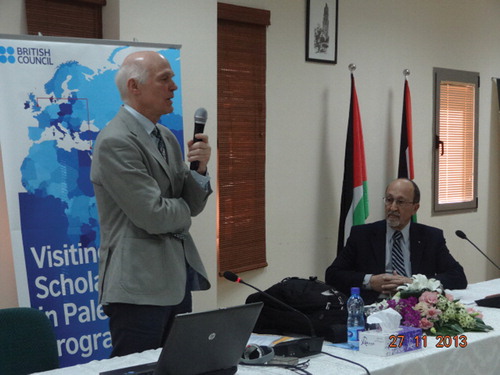
None, apart from Dr Butler, had visited the oPt before—and many told me they found it to be a fascinating yet depressing experience. Briefings and tours by UN agencies, local academics and NGOs revealed to them, in the short time they had here, the reality of the occupation and continued settlement expansion, the restrictions on movement and access, and the impacts of the Separation Barrier.
Some of the visiting scholars have directly written and/or spoken about their experience in the oPt (Callinicos, Wade), others have integrated it into their teaching and research (Richmond, Wade, Sriram) while one has developed a partnership with a Palestinian institution leading to ongoing discussions about more visits and joint grant applications (Butler). Many of the lectures/workshops were recorded and are available as podcasts on the Kenyon Institute Youtube website (with links also available from the CBRL website), where they can be downloaded.
Attendees of the 2013 Yusuf A. Sayigh Development Lecture (co-sponsored by the VSP programme), MAS, Ramallah, 27 November 2013
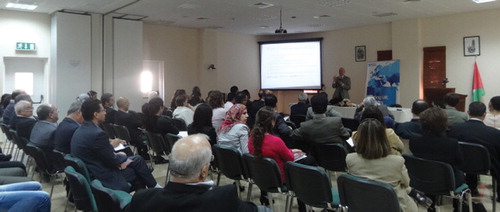
As the programme goes into its third year, both the KI and the BCP have benefited from the partnerships developed with Palestinian universities, research centres and NGOs, and we aim to take this forward in new and exciting ways.
Mandy Turner, Kenyon Institute Director, 9 June 2014
CBRL Academic Arabic Language Programme
CBRL & Institut français du Proche-Orient (IFPO) Beirut, Summer 2014
Thanks to a generous grant from the British Academy Languages and Quantitative Skills initiative, the first CBRL Academic Arabic Programme was delivered in collaboration with the Institut français du Proche-Orient (IFPO) in Beirut. The CBRL was able to offer bursaries covering the tuition fees, accommodation, and travel expenses for ten academics and postdoctoral researchers based in UK universities and research institutions.
Dr Daniel Neep, former CBRL Research Development Director and promoter of the CBRL Academic Arabic Programme, stressed the importance of this initiative to fill a gap in existing language provision by providing UK-based academics and established researchers in the humanities and social sciences with short but intensive Arabic language courses tailored to refresh their already advanced language skills. The Programme aimed to meet the specific academic and research needs of its participants by combining traditional Arabic language training sessions for foreign learners with content-rich seminars held in Arabic exploring a variety of themes crossing disciplinary boundaries and replicating the intellectual environment of a university course.
The Programme was originally scheduled to take place in September 2013. However, due to the unstable political situation in Lebanon and neighbouring Syria, it was postponed and finally took place at IFPO Beirut between the 14th and the 25th of July 2014. The two-week course encompassed 40 hours contact hours, with 32 hours of group classes and 8 hours of individual tutorials. The subjects of both collective and individual classes included: Arabic Grammar, Media and Society, Syrian dialect, Listening and Comprehension, Modern Literature, Contemporary History, Oral Presentation Skills in Standard Arabic, and Written Exposition. Under the supervision of Eric Gautier, the co-ordinator (‘Responsable’) for Arabic language courses at IFPO Beirut, the small group seminars and individual tutorials were led by a group of dedicated Syrian and Lebanese academics, researchers and civil society activists, who have accumulated years of experience teaching Arabic to foreign students. It was a real privilege to engage with the teachers in stimulating cross-cultural conversations about the critical socio-political and economic developments in Syria, Lebanon, Palestine, Egypt, Jordan, and other countries in the Middle East and North Africa.
The listening and comprehension sessions taught by Abdullah Al Fakri using short video reports taken from the BBC news in Arabic enabled us to assess our level of comprehension and vocabulary on current news in the Middle East. The oral presentation sessions by Maha Abou Hamra helped us to enhance our oral presentation skills in Modern Standard Arabic, using appropriate logical connectors to develop consistent and well-organized accounts on topics of our choice. In the literature classes with Dr Jamal Chehayed, we read and commented upon the work of some contemporary poets and writers, including Maron Abboud and Mohammad Al- Maghout, and we discussed the caricatures of Ali Farzat, the renowned Syrian political cartoonist and editor of the satirical periodical Al-Domari (‘The Lamplighter’). In the society classes with Dr Hassan Abbas, we broadened our academic Arabic vocabulary by debating definitions of state, citizenship and vulnerable social groups, and by comparing the condition of women, children and refugees in Western and Middle Eastern societies. Drawing upon the work of Arab and Western historians, Tarek Aziza explored with us key events in Middle Eastern history, including the establishment of the state of Israel and the connected Palestinian refugee exodus, the Lebanese civil war, and the current conflict in Syria. The grammar and written exposition classes with Ahmadia al-Nasan were very useful to revise complex Arabic grammar rules including verb tenses, forms and conjugations, case endings, numbers, and conditional statements.
Those who took the Programme are a group of young and passionate researchers and academics with expertise in a wide range of topics in the fields of anthropology, history, literature, political science, international relations and migration studies. Levels of proficiency vary in written and spoken Arabic, as well as in standard Arabic and in various Arabic dialects. Consequently, everyone agreed that the individual tutorials were the strength of the Programme because they allowed participants to focus on the topics and research materials concerning their own research projects and disciplines, as well as to address personal weaknesses in language and to practice the form of Arabic in which they specialize.
The collective and individual lessons were accompanied by a series of evening events including Dr Jamal Chehayed’s lectures in Arabic on the ‘Panorama of Modern Syrian Novel’ and ‘The Slogans of the Syrian Revolution’, and the debate between Dr Said Abdul Rahman and Tarek Aziza on ‘Salafism as a Doctrine and as a Programme’. Some participants were pleased by their ability to follow such articulate academic discussions in Arabic and being able to ask questions and engage in the following Q&A sessions.
IFPO Beirut offers an ideal venue for the collective and individual classes and excellent research and study facilities including free Wifi internet and public access to the collection of books and journals in Arabic and in French of the Bibliotheque Henri Seyrig. After an intense week of study, participants could socialize and participate in extra-curriculum activities, including joining the badminton and table tennis tournaments in the courtyard of IFPO—in the safe premises of the French Embassy in Beirut. The Academic Arabic Programme provided networking opportunities for participants who exchanged their email contacts with fellow classmates and with the teachers in order to be informed about similar CBRL- and IFPO-led initiatives in the future. At the weekend, some joined an organized excursion to the beautiful Tannourine Cedars Forest Nature Reserve in the North of the Mount Lebanon range, the largest remaining Cedar forest in the country, also containing several species of protected animals, including Persian squirrels, badgers, wild boars and rare wolves.
Overall, the participants of the first CBRL Academic Arabic Programme believe that this was an excellent course and wish to express their gratitude to the CBRL for this great opportunity to refresh and enhance their Arabic language skills. They would participate again in the programme next year, if the course will be repeated, and would recommend to other scholars studying the Arab world to participate in this enriching language, cultural and intellectual exchange.
Vanessa Iaria
CBRL Postdoctoral Research Fellow 2013/14, British Institute in Amman
Translation and Interpreting Studies Workshop Series Sponsored by the British Academy
Second Workshop held at the CBRL British Institute in Amman, 2–4 September 2013
With the support of the British Academy, in conjunction with the British Institute in Amman, the second of a series of workshops designed to build capacity among the younger generation of university academics in the Middle East and North Africa took place in Amman in September 2013. The initiative was originally launched by the Middle East and North Africa Panel (MENAP) of the British Academy in 2010, in recognition of the fact that early-career scholars in the region tend to face problems in terms of knowledge of latest developments in the field and ability to follow the literature, and in terms of access to resources. Capacity building at this level aims to create an environment where Arab, Turkish and Iranian colleagues are better able to deliver up to date training to their students, conduct their own research and supervise doctoral research effectively, strengthen their research profile and publish in international outlets. The first workshop was held in Amman in September 2011 (see CBRL Bulletin 7, 10–12).
The workshop was led again by Prof. Mona Baker (University of Manchester, UK), with new lecturers Dr Carol O’Sullivan (University of Bristol, UK) and Dr Christopher Rundle (University of Bologna, Italy and University of Manchester, UK). A total of 21 delegates attended, 11 female and 10 male. They included participants from Palestine (Ramallah, East Jerusalem, Hebron and Nablus), Egypt, Algeria, Oman, Jordan, Lebanon, Tunisia, Yemen, Iran and Turkey. Four delegates from Gaza, two female and two male, were unable to join the workshop because of travel restrictions. Additional financial support from the British Council enabled more Palestinian participants to attend the event.
The three-day programme included lectures and seminars on the following topics: Scope, Purpose and Meaning of ‘Theory’ in Translation Studies (MB); Introduction to Audiovisual Translation (CO); A Case Study of Censorship of Translation in Fascist Italy (CR); The Narrative Approach to Translation (MB); Methodology in Translation History (CR); Audiovisual Translation Research Methods (CO); Developing and Delivering a Training Course in Subtitling (CO); Theoretical Issues in Translation History (CR). There were two Q&A sessions: Identifying Research Topics and Designing Research Projects; and Writing Academic Papers and Publishing in International Venues.
The workshop ended with an evening of public lectures co-sponsored by the British Council in Amman, held at the British Council in Jebel Amman, on the theme of The Politics and Ethics of Translation and Interpreting. Prof. Ebru Diriker (Boğaziçi University, Turkey) delivered a lecture entitled Ethics and Politics of Conference Interpreting: Revisiting the Status of the Profession(al). Prof. Farzanah Farahzad (Allameh Tabataba’i University, Iran) delivered the second lecture, entitled Translation in the Post Revolution Period in Iran.
Delegates were able to extend their stay in Amman and attend a two-day symposium at the University of Jordan on Thursday 5 and Saturday 7 September, thanks to a generous grant from the British Council. The theme of the symposium was Translation and Interpreting as Social Practice. It featured plenary presentations by Professor Mona Baker, Prof. Ebru Diriker and Prof. Farzaneh Farahzad, as well as three workshops by Dr Carol O’Sullivan, Dr Chris Rundle and Professor Mona Baker.
As with the earlier workshop, the outcomes of this workshop cover three main areas: knowledge transfer & capacity building, networking, and resources. In terms of knowledge transfer and capacity building, the workshop set out to offer participants who are largely cut off from mainstream disciplinary developments an intensive introduction to some of the latest thinking on translation and interpreting. Unlike the 2011 workshop, which focused on theoretical models and methodological innovations, in the 2013 workshop the discussion of theory and methodology was supported by detailed presentations of case studies. At the same time, the two Q&A sessions addressed generic issues of interest to all academics, such as designing research projects and adopting appropriate strategies to maximize chances of publishing in international venues.
Lecturers and Participants at the Second Translation Studies Workshop, British Institute in Amman, September 2013. Front row, from left: Dr Lamis El Nakkash (Cairo University), Dr Ikrimah Shehab (Najah National University), Prof. Yesim Ebru Diriker (Boğaziçi University), Prof. Mona Baker (University of Manchester), Dr Christopher Rundle (University of Bologna; University of Manchester), Dr Carol O’Sullivan (University of Bristol), Dr Rania Yacoub (Applied Science University (ASU), Dr Carol Palmer (BIA Director). Second row, from left: Mr Mazdak Bolouri (Islamic Azad University, Qazvin Branch), Dr Ahmad Ayyad (Al Quds University), Ms Ayşenaz Koş (Boğaziçi University), Dr Hilal Erkazanci Durmus (Hacettepe University), Mr Khaldun Sughayyar (Palestine Polytechnic University), Dr Mohammed Farrah (Hebron University), Dr Abdul Gabbar Al-Sharafi (Sultan Qaboos University), Dr Nuwar Moulawi Diab (Lebanese American University), Dr Baya Lekkal (University of Algiers 2). Third row, from left: Ms Layal Merhi (The Lebanese University), Dr Marwa El Zouka (Alexandria University), Dr Amal Mohammad AbdelMaqsoud (Ain Shams University), Ms Fatemeh Parham (Allameh Tabataba’i University), Dr Atef Hedhili (Institut Supérieur des Sciences Humaines de Tunis). Standing in the back, from left: Mr Majdi Abu Zahra (Birzeit University), Mr Ali Beikian (Chabahar Maritime University)
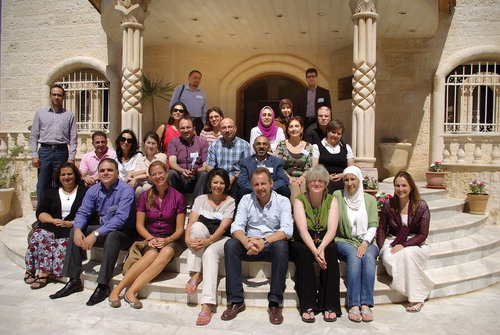
Networking is a welcome by-product of any initiative of this type, and in this case was again much enhanced by the opportunities for relaxed, friendly exchange afforded by an informal venue (the British Institute premises were ideal in this respect). This year, networking opportunities were further enhanced by a dinner at the Dead Sea following the public lectures on 4 September, and an excellent day-long trip to Petra on 6 September.
Finally, in terms of Resources, the intranet section of the Translation Studies Portal (www.translation studiesportal.org/ar), set up in 2011, was used to provide access to reading material prior to the workshop. All workshop sessions were video recorded, and the videos and powerpoints of presentations have all been uploaded to the intranet section of the site. Delegates from Gaza who were not able to join the workshop have been given access to this material. The site continues to offer a growing set of resources that are particularly relevant to scholars in the Arab World, Iran and Turkey. They include announcements of events and publications, links to major sources of information and data, a media library which features video and audio material, and a Resources section which provides access to publications, powerpoints and teaching hand-outs that cover major theoretical and methodological approaches in translation studies. Statistics indicate the growing popularity of the site and its continued usefulness both within and beyond the remit of the BA Workshop series. Between 1 January 2013 and 31 January 2014, Google Analytics lists 29,930 site visits including 17,988 absolute unique visitors and 72,913 page views. The largest number of site visits were from Iran (c. 18%), followed by the UK (c. 9%), US (c. 7%) and then Egypt (c. 5%). Many visitors to the site who access it from the UK and USA are Arab, Turkish and Iranian PhD students, as evident from their site profile, i.e. information they enter about themselves when they register on the site.
Unsolicited responses from delegates received after the workshop have been extremely positive. They suggest that the workshop has achieved its aims, that the experience is appreciated by all concerned, and that it will inform teaching and research for years to come, gradually benefiting a larger cohort of academics and students in the region than those who actually attended the workshop.
A short promotional film of the workshop can be viewed on the British Academy’s YouTube site, on the Translation Studies Portal and on the CBRL website. The video was shown at the British Academy’s annual language event in November 2013.
Mona Baker, University of Manchester, and Carol Palmer, CBRL
The ‘Arab Spring’s’ Missing Dimension—Views from the Countryside
Thimar Research Seminar held at the British Institute in Amman, 28–30 September 2013
This discussion seminar was held in partial fulfillment of a British Academy ‘Arab Spring’ Award to CBRL to investigate rural transformations leading up to and during the Arab Uprisings. Its main feature was the screening and associated discussion of a documentary film by Ray Bush (Leeds University) and Habib Ayeb (Université-Paris 8) on their fieldwork in Tunisia and Egypt in 2013 funded by the same award. The seminar brought together members of the Thimar collective, a group of researchers investigating agriculture, labour and environment, to provide feedback on the first cut of the film, as well as to share their own research experiences. The original BA award was made in early 2012, but fieldwork was postponed until 2013 due to the administrative and teaching responsibilities of Professors Bush and Ayeb. Fieldwork in Egypt was undertaken during the period of Muslim Brotherhood rule and Mohammed Morsi’s term as president, but the seminar took place after the military coup in June 2013 when the ancien régime returned under the leadership of President Abdel Fattah al-Sisi.
Bush and Ayeb’s film and their broader research project explore the position and perceptions of small farmers during the Tunisian and Egyptian uprisings of 2010 and 2011. Persistent economic turmoil and political authoritarianism in both countries had an enormous impact in the countryside, and the film gives small farmers the opportunity to share both long-standing and immediate fears and concerns about farming, their families and politics. It also asks whether or not the farmers felt the declared aims of the uprisings had been achieved.
The film, at the time of the seminar called Forgotten Voices: Farmers and Revolution in Tunisia and Egypt, and now simply entitled Fellahin (‘Peasants’), was recorded in February 2013 in Tunisia and in May 2013 in Egypt. The film has three sections: Farmers and Farming; Uprising, and Fighting Back. These, in turn, introduce the farmers, give them the opportunity to voice what they understood by the periods of political transformation and turmoil as it affected them, and highlight the different forms and types of resistance in which they have engaged. The film combines interviews, voice-over and views of the locations in which the farmers live. In Tunisia, filming took place in the South in the Oasis Gabes and surrounding steppe, and in the North in the richer ecological areas of larger estate plantations in the district of Testour, not far from the capital, Tunis. Filming in Egypt took place in Cairo, Dakhalaya, Fayoum, and Alexandria, including farmers in the densely populated Delta, an oasis, and an inner city village, respectively.
The film shows a mismatch between rural political consciousness and agricultural strategy, strong peasant populism among small farmers, and a robust analytical sense of what went wrong to produce Egypt and Tunisia’s rural development failures. Since economic liberalization began in the late 1980s, small farmers have been ejected and expelled from ‘development’. Specifically, farmers in Egypt lament the continued lasting consequences of Law 96 of 1992 that ended rights in perpetuity for tenants and raised rents exponentially. Farmers in Tunisia are critical of the failure of policy to address access to potable water and improved and affordable irrigation. In both countries farmers are critical of larger landowners and merchants, who are viewed to have benefitted from decades of economic liberalization in the countryside, as well as of policymakers implementing strategies. While farmers do not feel that uprisings have improved their condition in any way, the film demonstrates a heightened willingness to speak out and engage in resistance to the economic policies that are seen to have marginalized them. The Egyptian case provides a unique insight into one community’s mobilization around tamarod, the mass petition that contributed to the toppling of President Morsi. Mr. Morsi was not seen as a President able or willing to curb the power of landlords.
At the Thimar Research Seminar in September 2013, Yasmine Moataz’s (University of Cambridge) presentation, ‘Encountering the Egyptian State in Revolutionary Times’, picked up on the theme of land dispossession in Egypt while providing examples of cases where small farmers have contested their land claims through the judicial system. Carol Palmer (CBRL) and Waleed Gharaibeh’s (University of Jordan) paper on ‘The Politics of Development in Ghor al-Safi’ also explored a case of contested land claims following the redistribution of land as part of irrigation and industrial development of potash extraction during the 1980s and subsequently. Their team is also mapping landscape changes and interviewing local people, while employing GIS techniques in the analysis of socio-spatial change. Documenting agrarian changes though landscape analysis and ethnography was the subject of Martha Mundy (LSE), Rami Zurayk, Saker el Nour, and Cynthia Gharios’s (all AUB) talk, ‘The Palimpsest of Agrarian Change’, on the development of the village of Sinay in southern Lebanon.
Water was the focus of presentations by Mauro van Aken (Università degli Studi di Milano-Bicocca) on the Jordan Valley and Karim Eid Sabbagh (SOAS) on Lebanon. Both demonstrated how development agendas prioritize the interests of investor and state agencies over small farmers and communities. Karim Eid Sabbagh’s presentation, ‘A Political Ecology of Water Resource Management in Lebanon: an investigation of water sector reform’, discussed how reforms remain incomplete but fit well with neoliberal discourse (‘the playbook’) and existing power relations. In the Jordan Valley, Mauro van Aken’s perspective, entitled ‘Water Crisis, Marginality and Struggle for Resources in a High tech Environment—the Jordan Valley’, demonstrated that water is not only an economic resource but also a social one. Rami Zurayk gave a highly engaging presentation, ‘Power Games and Role Plays: The Red Lebanese resists in the Bekaa Plain’, on his and Helene Servel’s research. They showed a way in which farmers can make a living from the production of a crop (cannabis) for which premium prices can be attained, distribution is locally managed, and where resistance is also part of the motivation given the illegal status of the crop.
Myriam Ababsa’s (IFPO Amman) talk, ‘Rural Land Issues in Contemporary Syria’, on agricultural production in the years leading up to the Syrian crisis, when there was drought in north-west Syria, and how this is playing out in the context of the current conflict, prompted intense discussion. Going much further back in time, Falestin Naili (IFPO Amman) presented ‘History and Collective Memory of the Village of Artas in Palestine’, on the Christian missionary Baldensperger family from Alsace who lived in Ottoman Palestine in the nineteenth and early twentieth centuries and their surprisingly long-lasting impact.
Thimar seminar participants visiting Tell Deir ‘Alla in the Jordan Valley. Left to right: Yasmine Moataz, Martha Mundy, Carol Palmer, Mauro van Aken (rear), and Karim Eid Sabbagh
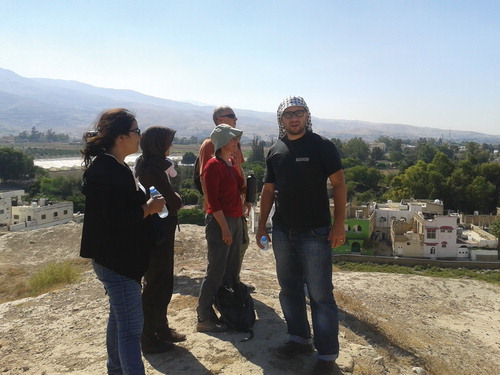
The trip on the final day of the seminar allowed discussions to be continued, inspired by the dramatically beautiful landscape of the Jordanian Rift. Starting in Amman, descending the Wadi Shu’aib to the Jordan Valley, participants discussed climate, water catchment, refugees, and irrigation policies en route to and at the top of Tell Deir ‘Alla, an archaeological mound, in the village where Mauro van Aken had lived during his PhD research. While driving down half the length of the Jordan Valley and the whole of the Dead Sea, past luxury spa hotels, the industrial complexes of the Arab Potash Company to Ghor as Safi, subjects ranged from the dropping levels of the Dead Sea, to tourism, agriculture, and international business connections and politics. At Safi, Carol Palmer presented her team’s research and the history and development of Safi from Deir ‘Ain Abata, the Byzantine archaeological site commemorating Lot’s Cave. While some members of the party returned straight to the airport, a few visited the home of a female farmer, originally Egyptian, who has made a success of diversifying her production, has a local market (the Potash factory skilled workers) to whom she directly sells her produce, and maintains her own seeds stocks, with a small loyal team of workers.
In summary, film is an immensely powerful medium to document the human dimension of agrarian change currently facing the region. Initial film screenings of Fellahin will take place at the Tunisia Film Festival, ‘Douz Doc Days’ and at ‘Taking Soundings’ part of the Leeds City Forum for debate and engagement, both in October 2014. More activities of the Thimar group are reported on its website (www.athimar.org), the development of which has also been supported by the British Academy Arab Spring Award.
Ray Bush, University of Leeds, and Carol Palmer, CBRL
Secrets of Tafileh: Local Assets for Community Empowerment and Development
Conference held in Tafileh, Jordan, 2–4 April 2014
The conference ‘Secrets of Tafileh: Local Assets for Community Empowerment and Development’ was held in the city of Tafileh, Jordan, 2–4 April, 2014. The initial spur for the conference came from a request from the Minister of Tourism and Antiquities, HE Prof. Nidal Katamine, that CBRL collaborate with the Ministry and the Department of Antiquities to hold a conference which would promote the diversification of tourism, particularly in the area of Tafileh. CBRL enthusiastically accepted the proposal, particularly as a result of its strong research history in the Tafileh area. Initial conference concepts were developed by Dr Carol Palmer and Dr Paul Burtenshaw, before being further developed in conjunction with HE Dr Monther Dahash Jamhawi, Director-General of the Department of Antiquities and Ms. Ansam Malkawi, minister advisor at the Ministry of Tourism and Antiquities.
The conference represents a formal action in a nascent but strong trend of developing a range of tourism offerings in Jordan and connecting them to local communities. Jordan’s tourism sector, particular heritage tourism, has been heavily reliant on major sites and their associated hubs. This exposes Jordanian tourism to political or economic instability in the region or source markets. Regional and thematic diversification is key for the sustainable future of tourism in the country, including the aims of encouraging tourists to stay longer, reducing pressure on major sites, and the greater inclusion of the public in the industry’s benefits. Within archaeology, a clutch of international and Jordanian-led projects have been attempting to develop new attractions and tie their success to the communities around them. The Department of Antiquities itself is trying to better connect archaeology to tourism and the public, while in broader terms the community participation models and tourism success of the Royal Society of the Conservation of Nature (RSCN) and the Jordan River Foundation is a key influence.
The location of the conference in Tafileh was in part led by institutional connections but was also ideally suited to this theme. The area has an unfortunate reputation as a somewhat conservative area with little to see, and the location of the conference met with several surprised responses in Amman. Our response tended to be that that was precisely the reason—to demonstrate to the local community, and to the rest of country that the area had great attractions and potential as a tourist destination. In the process of assembling the conference, a variety of projects working in Tafileh were unearthed, including some that had begun the process of tourism development. As a result, a core aim of the conference became to aid communication between these projects and act as a forum for collective action of often disparate and isolated initiatives. There was great work being done but there clearly needed to be a way to make such efforts mutually collaborative.
Front cover of the booklet produced to accompany the ‘Secrets of Tafileh’ conference, 2–4 April 2014
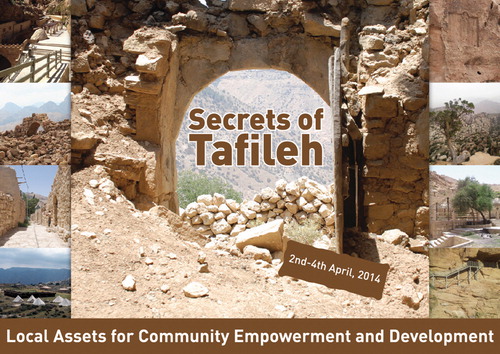
The thinking behind the conference programme was to reveal the ‘secrets’ of the area and discuss how they could best be mobilized for community and local-led tourism. The conference was designed to have strong local involvement. The sessions were held in the city of Tafileh itself and participation by local people was strongly encouraged. The conference was designed not only to promote the region to those within it and outside it, but also to provide the practical information, models and inspiration for local communities to fashion their own projects. Commensurate with this aim, the main meals for the conference were provided by local community groups; local women displayed their crafts for a conference bazaar, and events were hosted by local communities, namely the villages of Ma’tan, Sela’ and the RSCN Rummana Campsite. In addition to this, conference participants were accommodated in a local community-run hotel in Dana village. This provided encouragement to these groups, but allowed participants to get a true flavour of the region.
To achieve its aims, the conference was organized around a variety of sessions over two days. The opening ceremony, held in the stunning landscape of Dana Biosphere Reserve, was attended by several hundred local community members to hear speeches delivered by the Governor of Tafileh, representatives of the Minister of Environment and Minister of Culture, Dr Carol Palmer and HE Prof. Nidal Katamine, Minister of Tourism and Antiquities. The conference sessions themselves were held at the Tafileh Development Foundation, beginning with an introduction to the ‘secrets’ of the area including its archaeology, Dana Biosphere Reserve, Feynan Ecolodge and the activities of the Dana community. This was followed by representatives of several tourism and development projects which have been active in Tafileh: the Ministry of Tourism and Antiquities, the Ministry of the Interior, USAID and the Ministry of Planning and International Co-operation, as well as an introduction to the built heritage of the area.
The second day began with perspectives from international experts, designed to showcase models which might prove useful to local initiatives. Dr Aylin Orbaşli (Oxford Brookes University), Dr Paul Burtenshaw and Prof. Michele Trimarchi (Catanzaro and University of Bologna) showed examples of community heritage tourism and the use of culture in the economy before Eng. Ghaleb Qudah introduced the work of the Jordan River Foundation in the area. The final formal session featured representatives of a variety of funding bodies providing information on their schemes and how local communities and individuals could apply for support. The conference ended with a session chaired by Dr Monther Jamhawi hosting responses to the conferences as a whole.
The discussions during these sessions were characterized by pragmatic appraisals of the situation in Tafileh, including some frank statements about local responsibilities and resilience, and the need to not depend on outside grants. While sustained broad local participation over the two days proved challenging, significant numbers of the local community and tourism leaders attended and were at the centre of debates. Practical points raised in the final session included the ease of access to and bureaucracy around available grants, and the need to increase communication between projects, government departments, funders and local people. This included an eagerness to hold the conference in Tafileh again, where it was hoped there would be subsequent successes on which to report. The conference certainly succeeded in its primary aim of raising the profile and potential of the area, and gave initial momentum to long-term transformations in the area’s tourist offering. The challenge now is to translate this first step and discussion into long-term benefits for the people of Tafileh.
Paul Burtenshaw
Sustainable Preservation Initiative, CBRL Research Fellow 2013/14
OBITUARIES
Talab Damaythan Rashaydah (Abu Fawaz), 1954– 2013
Talab Damaythan Rashaydah (Abu Fawaz), CBRL guard in Wadi Faynan, Jordan, died on 21 December 2013 aged approximately 59 years old. Like most Bedouin of his generation, his exact date of birth was unknown. For CBRL Amman, Abu Fawaz was synonymous with Wadi Faynan and his picture featured on the cover of the CBRL Bulletin, volume 3 (2008). He served as CBRL guard for more than 20 years since the start of the then British Institute at Amman for Archaeology and History’s (BIAAH) Wadi Faynan Project. Recruited by William Lancaster, former BIAAH Director, Abu Fawaz was famous for his hospitality, proud Bedouin identity and intimate knowledge of the Faynan and Shawbak areas. Abu Fawaz’s tent, since 2000 pitched in the garden of his Faynan village home, welcomed every archaeologist working in the Faynan area for a generation. Like many Bedouin, Abu Fawaz’s first career was in the Jordanian army in which he served for about 20 years. As a deeply respected member of his community, he served as mukhtar, or village head.
Abu Fawaz in 2000 at the start of a trek up the Wadi Burwas trek. See ‘‘Finding Out’: An Expedition in Southern Jordan’, CBRL Newsletter 2001, 11–14
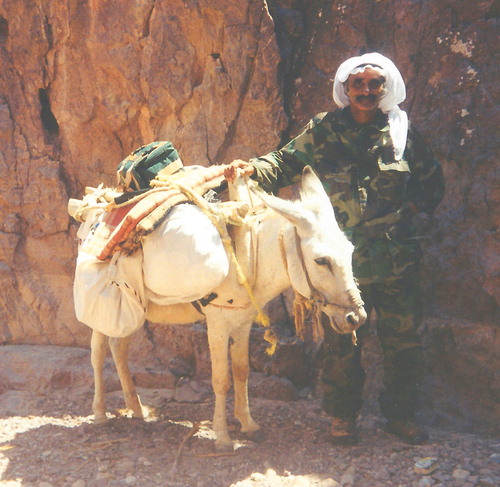
Abu Fawaz serving as guard for the Wadi Faynan 16 excavations as depicted on the cover of the CBRL Bulletin 2008

Abu Fawaz will be remembered for his sense of justice and honour, generosity and gentle humour, as well as his story-telling abilities and kind-hearted care for his livestock, especially his much loved camel. He is survived by his wife, five children and many grand-children; he was always above all a proud family man who adopted CBRL as part of his extended family. Allah Yerhamo.
Carol Palmer
Abu Fawaz remembered by Alison McQuitty, former BIAAH Director and first CBRL Director
Abu Fawaz’s eyes twinkled—as always—while, in unison, we stomped our Gulfi dance of welcome on the banks of the Wadi Ghuweir. And that is what I will always treasure—his innate ability to have a sense of fun and the absurd when appropriate as well as his sense of solemnity and ceremony. He helped countless CBRL staff, dig directors and passing tourists navigate the intricacies of Wadi Faynan and Bedouin etiquette and answer with graciousness the oddest of questions or instructions they might come up with. When a mensaf needed organizing, he was the man. Abu Fawaz loved and was proud of his heritage: he and his donkey were the stars of the walking tours that Fridtjof and I led during the years of Idrisi Travel. He suggested the routes; with his family, ensured that the logistics ran smoothly even arranging for a white plastic chair and a fold-up bed to be brought to a campsite far from any tracks for clients with dodgy hips and a fear of scorpions; and with his family and Jouma, he made sure that the values of hospitality shone through. After one of these tours a client wrote: ‘An image etched in my mind is us descending from Dana looking as if we had just been let out of a high-dependency unit complete with tubes from the waterbottles and all of us in serious walking gear—and then noticing Abu Fawaz skipping over the rocks in black suede slip-ons.’ One of my own favourite memories of my time as Director is sitting in companionable silence with Abu Fawaz in his tent, looking up at the magnificent Dana massif and sipping excessively sticky tea.
Ghazwa Qasem Malhas, 1944–2013
Ghazwa Malhas passed away suddenly on 7 November 2013, and her passing left a very large hole in the life of the CBRL British Institute in Amman (BIA). Ghazwa had retired but came out of retirement to work as part-time Librarian at the Institute, and enlivened the BIA with her gregarious, amiable personality and refreshing outlook on life. Since her appointment in June 2012, she worked tirelessly with Rudaina Momani, then BIA Library Assistant—and now current Librarian, to improve the organization and user-friendliness of the BIA library. Outgoing and passionate about her work, she enjoyed problem solving and mentoring, and strove to do her best at all times.
Ghazwa Malhas (left) and library assistants Rudaina Momani (centre, now British Institute librarian) and Muna Slaihat in the British Institute in Amman Library, summer 2012
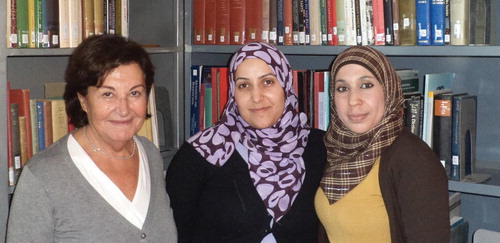
Ghazwa Qasem Malhas was born on 1 April 1944 and attended Ahliyyah School for Girls, Amman, before graduating from Beirut University College with a BA in Psychology in 1966. She received her Post Graduate Diploma in Library Sciences from Leeds Polytechnic (now Leeds Met) in 1976. During her long and distinguished career as a librarian, she worked at the University of Jordan, Yarmouk University, and Al-albayt University in prominent roles. She also worked as librarian for two UN agencies (ECSWA and UNICEF), and the Royal Scientific Society (RSS). For 15 years prior to her retirement, she worked for the Jordanian government at the National Information Center and the National Technology Information Center where she was responsible for establishing government information committees at the national level for various sectors. She also worked for the government section on internet domain name registration.
Ghazwa came from a prominent Jordanian family and her father founded the first Jordanian-run private hospital in Amman, near to First Circle on Jabal Amman. Her family loved books and valued education highly. Two brothers, one who sadly predeceased her by only a few months, continued the family tradition in medicine along with one sister who became a nurse, with her other brother becoming a well-respected mathematician. A measure of her family’s progressive credentials is that her elder sister was the first Jordanian woman to obtain a Jordanian driving license. Ghazwa was indeed very close to and proud of all her brothers and sisters, and loved to spend time with them and their children.
After retirement, Ghazwa moved to a modern flat in a lovely apartment block in West Amman, which she furnished beautifully from existing family possessions, refusing to buy anything new. There, as well as taking care of her mother, she took upon herself the role of co-ordinating a residents association and creating a beautiful garden. Once, while in the midst of organizing a lunch for residents, she commented that her neighbours didn’t like being organized at first, but then they got to like it and that now they wouldn’t let her stop! She came to work at the Institute following her mother’s passing, looking for a stimulating activity with which to fill her time and that would enable her to continue her great love and appreciation for books.
In addition to all her other commitments, Ghazwa had many friends, with whom she met regularly, especially for lunch, and loved to go swimming and to travel. In September 2013, she was able to fulfil a lifelong dream of travelling to Russia on a trip organized by the Friends of Archaeology and Heritage. Whilst travelling she liked to take photos, but equally liked to tell people that she was a terrible photographer.
Ghazwa was very popular at the Institute for her vivaciousness, sense of humour and stimulating conversation, drawing extensively on her reading and knowledge and experience of the world. She loved to have people use the library and disliked quiet periods such as during Ramadan. Staff and patrons of the British Institute were very lucky to have had the opportunity to work with her. She is very much missed.
Carol Palmer and Justin Yoo

